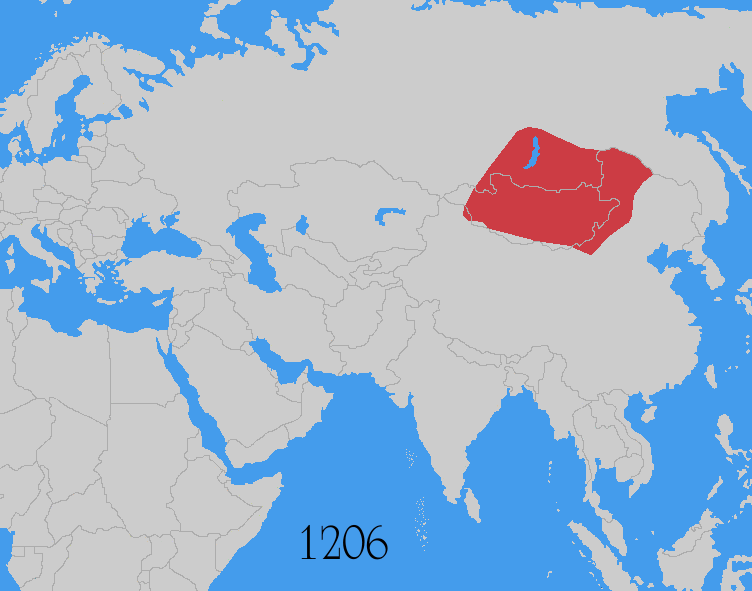Chapter 12 Transformations in Asia, 220-1350 A.D.
In the mid-1200s, a new group of nomadic invaders from Central Asia, the Mongols, invaded the Chinese Empire and soon swept across Eurasia conquering as they went. Eventually the Mongols spread from China to Eastern Europe, Syria, and the borders of India. Under the authority of the Great Khan, who ruled from his capital at Karakorum, the Mongol Empire united Eurasia as no empire had ever done before. An imperial postal system carried letters across the continent in a matter of weeks. Under the Mongols, the flow of people and ideas across Eurasia accelerated, bringing all the regions of the continent into closer contact.
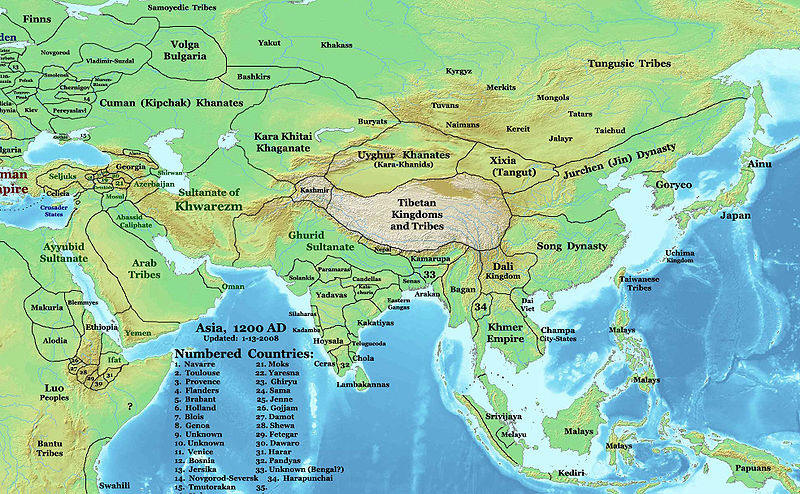
The Rise of the Mongol Empire
Like the Turks, to whom they were related linguistically and culturally, the Mongols were a pastoral and nomadic people who emerged in Central Asia, in present-day Mongolia. There they made seasonal migrations between the Onon and Kerulen rivers, as they searched for pasturage for their herds and flocks. Living such a life, they became master horsemen, used to fighting and raiding as they competed for survival on the scarce grazing lands. In the 1100s, however, this pattern of Mongol life changed dramatically under a new leader, Temujin, better known to history by the title Genghis Khan.
BIO Temujin. Temujin was born the son of a petty Mongol chieftain sometime around 1167. Orphaned about the age of 12, his early years were full of struggle. Apparently even as a child, however, he determined one day to rule the Mongols. After years of struggle and bloodshed, in 1196 several Mongol leaders proclaimed Temujin khan, or king, of the Mongols:
"We have resolved to proclaim thee khan. We will march in the van into battle; if we carry off women and girls, 'twill be to give them to thee. We will be foremost in the hunt; if we catch game, 'twill be to give it to thee."[16]
The once-abandoned orphan accepted the khanate, taking the new name of Genghis Khan.
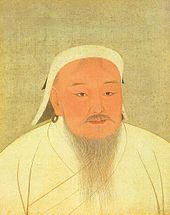
Genghis Khan had decided early on to expand his power by overcoming the limitations of the traditional Mongol kinship system. He began to organize his people according to ability, rather than family ties or social standing. Above all, he organized his followers for war, building a highly organized army based on units comprised of ten, a hundred, a thousand, and ultimately 10 thousand warriors.
Battle tactics were those of the steppe nomads. Mongol armies stalked their enemies like prey. "In daylight," Genghis reportedly told his men, "watch with the vigilance of an old wolf, at night with the eyes of a raven. In battle, fall upon the enemy like a falcon."[17]
In 1204, Genghis summoned all the chiefs of the Turco-Mongol peoples of Mongolia to a great gathering, or quiriltai. There the assembled people proclaimed him khagan, or emperor. At the same time, he laid down the yasaq, or legal regulations, that were henceforth to bind all Mongols, even after his death. Although these regulations have not survived intact, we know that they imposed a strict discipline on civilians and warriors alike. The effects were later observed and recorded by Piano Carpini, a Franciscan friar travelling in the Mongol domain in the 1240s:
"The Tartars, that is, the Mongols, are the most obedient people in the world in regard to their leaders, more so even than our own clergy to their superiors. They hold them in the greatest reverence and never tell them a lie. There are no wranglings among them, no disputes, no murders. Only petty thefts occur. Should one of them lose any of his animals, the finder never keeps them, and may even return them to their owner. Their wives are very chaste, even when they make merry."[18]

Having united all the Mongols under his command, Genghis next set out to create an empire. In 1209 he conquered the nomadic empire of Hsi-Hsia, which had emerged on the borders of the Chin Empire in northwest China. In 1211 he attacked the Chin directly, but soon withdrew his forces and led them west. In 1217 he conquered the Tarim Basin. By 1222 the Mongols had taken all of Turkestan and Afghanistan, and Genghis himself had raided into northern India, while other Mongol forces operated in Persia and further north in Russia. When rebellion broke out in Hsia-Hsi, however, he returned to suppress it in 1224. He died in 1227 before the final destruction of the rebels.
Genghis's successors. After Genghis's death, the Mongol Empire was divided into four major khanates ruled by his heirs: the Khanate of the Golden Horde centered in southern Russia; the Persian Khanate of the Il-Khans ruled from Azerbaijan; the Khanate of Chagatai, with its capital at Samarqand; and the Grand Khanate that included the old Mongol homeland and the Chinese Empire. Ogodai, Genghis's third son, became Grand Khan over all the others and ruled the eastern part of the empire from Karakorum.
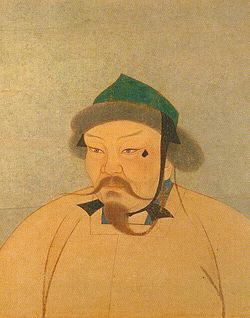
Ogodai Khan,
Ogodai also resumed the expansion of the empire. He finally defeated the Chin and took control of all north China. To the west, he sent 30,000 troops to consolidate the Mongol conquest of Iran. An even greater force of about 150,000 Mongols completed the conquest of the Russian steppes and ravaged Eastern Europe. In 1241 they reached Krakow in Poland, deserted by its inhabitants, and burned the city. Soon they had conquered not only Poland but also Hungary and had reached the Adriatic coast. Only Ogodai's death saved Europe from further invasion. As the Mongol leaders hurried back to Karakorum for the election of a new grand khan their armies left Hungary and returned to southern Russia.
In 1251, Mongke, one of Genghis Khan's grandsons, succeeded as Grand Khan of the Mongols. Like his grandfather, Mongke was a remarkably strong leader. He restored the strong central control over the empire that had been lost since Genghis's death. Heavily influenced by Nestorian Christianity, his mother's faith, Mongke practiced religious tolerance throughout his domains. He appointed both Buddhists and Daoists to high posts in the imperial administration, for example. He also received a Christian emissary from Louis IX of France, a Franciscan monk named William of Rubrick. To Rubruck he observed: "All religions are like the fingers of one hand."
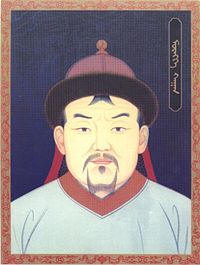
Mongke Khan
Mongke also continued Mongol expansion. Under his rule, his brother Hulagu completed the conquest of Persia, while Mongol armies also conquered and occupied Korea. Mongke and another brother, Kublai, were preparing a final assault on the Sung Empire, when the Grand Khan died in 1259.
The Yuan Dynasty in China
With Mongke's death, the old unity of Genghis Khan's empire began to break down. The various khans settled down to rule their new territories and gradually to adopt many of the ways and customs of the peoples and cultures they had conquered. After a brief succession struggle Kublai succeeded Mongke as Grand Khan. Kublai himself completed the conquest of the Sung. He established his own dynasty in China, the Yuan, or "First," and moved the capital from Karakorum to the present-day site of Beijing, which was called Khan-baligh, or "city of the Khan."
Kublai remained officially the Grand Khan, but in fact he was almost wholly preoccupied with China. Unlike Genghis, he began to adopt many elements of Chinese culture. Nevertheless, neither Kublai nor his successors in China ever forgot they were Mongols. Mongol rule in China was in fact a military occupation. The Yuan continued to expand their empire. Kublai, for example, sent armies south into Vietnam and east into Korea. He also led two expeditions against Japan, although both failed.
Distrusting the Chinese bureaucracy, the Yuan rulers suspended the Confucian civil service examination system. Although they had to rely on Chinese officials in the lower levels of the bureaucracy, they limited their advancement and filled higher posts with many non-Chinese. Towards the end of the dynasty, in the 1300s, the examination system was briefly restored, but Yuan rulers continued to distrust the Chinese.
While the initial conquest and early phases of Mongol rule were extremely destructive in China, the Mongols were not solely destroyers. They wanted above all to preserve China's ability to provide them with wealth. Consequently, they repaired the canal system on which Chinese agricultural prosperity depended. They also improved transportation facilities, partly for military purposes but also to encourage trade. They also encouraged overseas trade and did their best to halt piracy along the coasts. They built and improved roads to Central Asia and Persia. Foreign traders and merchants were often granted special trading privileges in the empire, to the disadvantage of Chinese merchants.
The Il-Khanids of Persia
While Kublai and the Yuan dynasty established themselves in China, in Iran, Hulagu Khan and his successors, the Il-Khans, ruthlessly conquered the old Abbasid and Saljuq territories. The extent of the Mongol terror was vividly described by a Muslim historian of the day:
"The luck-forsaken land lay desolate. . . .
In heaps on every side the corpses lay,
Alike on lonely path and broad high-way.
Uncounted bodies cumbered every street:
Scarce might one find a place to set one's feet."[19]
In 1258, Hulagu's forces sacked Baghdad, killing the last Abbasid caliph and as many of the family as they could find. Pressing on into Syria they also captured Damascus. As they moved further south, however, the Mongols encountered a hastily gathered Islamic force led by the Mamluks of Egypt. At Ayn Jalut, the Mamluks defeated Hulagu's army.
Ayn Jalut might have proved little more than a setback had it not been for an event far off in Asia - the death of the Grand Khan Mongke. Indeed, the Mongol defeat may have been due to Hulagu's absence from the army since he had been summoned back to Mongolia for the election of a new Grand Khan. By the time he returned to Iran, the Mamluks had learned Mongol battle tactics and were too formidable to defeat. An uneasy border emerged between the two powers in Syria and Iraq.
Although Hulagu himself apparently despised the Islamic religion, and did his best to destroy Islamic culture in his domains, eventually his successors converted to Islam. In addition, the Mongols relied on local Persian officials of the old bureaucracy to rule their new domains. Such officials, however, often died violent deaths at the hands of their suspicious masters. For a time in the late 1200s, the Il-Khan Argun relied heavily on Jewish advisors and officials. When he fell ill sometime in early 1291, however, his enemies instigated a major massacre of Jews throughout the empire.
In 1295, the Il-Khan Ghazan assumed the throne. A convinced believer, Ghazan restored Islam as the official religion of the state and did his best to rule as a legitimate Islamic ruler. It was Ghazan, for example, who finally repudiated the allegiance of the Il-Khanids to the Grand Khan in China. By the 1340s, however, internal struggle among Mongol princes had so weakened Il-Khanid rule that it finally collapsed and the empire fell into the hands of local dynasties.
The Golden Horde
Like the Il-Khanids of Persia, the Mongols who settled in southern Russia after Ogodai's death also soon converted to Islam. In a terrain that was similar to their homeland, they continued their nomadic way of life. Much as the Huns had done before them, they demanded tribute from the more settled peoples of the region. So long as local Russian princes paid the tribute, the Mongols of the Golden Horde, as they were soon called, left them to run their own affairs.
By the 1300s, the Golden Horde had come to rely on the strongest of the Russian principalities, Moscow, to act as its primary agent for regulating the affairs and collecting the tribute from the other Russian states. They granted the Muscovite ruler the title of Grand Duke. To symbolize their continuing dominance, however, once a year the khan of the Golden Horde came to Moscow and required that the Grand Duke publicly feed the khan's horse out of his own cap.
Such marks of subservience soon wearied Russian rulers and by the end of the 1300s Moscow had become the leader in a struggle against continuing Mongol domination. In 1378, the Muscovites actually defeated a Mongol army, only to have the Mongols burn Moscow to the ground two years later in retaliation. Not until the late 1400s were the Muscovite rulers able to gather sufficient strength, largely by annexing their Russian neighbors, to finally throw off the Mongol yoke.
[1]Note: Info. on Xuanzang (Hsuan Tsang) fm. Ency. Britannica, 15th ed., vol. 6, p. 104.
[2]C.P. Fitzgerald, China: A Short Cultural History (New York: Praeger, 1961), p. 260.
[3]Peter Lum, The Growth of Civilization in East Asia (New York: S.G. Phillips, 1969), pp. 121-22.
[4]Raymond Dawson, The Chinese Experience (New York: Scribner's, 1978), p. 130.
[5]Dun J. Li, The Ageless Chinese: A History (New York: Scribner's, 1965), pp. 206-07.
[6]Jaques Gernet, Daily Life in China (New York: Macmillan, 1962), p. 90.
[7]Note: fm. Edward H. Schafer, Ancient China (New York: Time-Life, 1967), p. 132.
[8]Edward H. Schafer, Ancient China (New York: Time-Life Books, 1967), p. 122.
[9]Lum, p. 189.
[10]Marion May Dilts, The Pageant of Japanese History (New York: Longmans, 1961), pp. 4-5.
[11]Henry Wiencek, The Lords of Japan (Chicago: Stonehenge Press, 1982), p. 32.
[12]Walter J. Sheldon, Tigers in the Rice (Toronto: Macmillan, 1969), p. 12.
[13] The Turkish tribes which converted to Islam are often referred to as Turkomans (Turkmen) to distinguish them from the non-Muslim Turks.
[14] Recorded by Ibn al-Jawzi in the Muntazam fi tarikh al-muluk as translated in J. A. Boyle (ed.), The Cambridge History of Iran, Volume 5, The Saljuk and Mongol Period (Cambridge, 1968), p. 48.
[15]Schulberg, p. 156.
[16]Quoted in Grousset, The Empire of the Steppes: a History of Central Asia, p.203.
[17]Quoted in Grousset, p. 224. ANNO: Small parties of scouts kept the enemy in sight while remaining hidden until the right moment. Riding close to discharge arrows from their deadly compound bows (more powerful even than the Welsh longbows later used in Europe) they would then retreat, hoping to draw the enemy into a waiting ambush. Other times the Mongols would simply appear suddenly in mass formation advancing at the trot in total silence, before finally charging at full gallop with unnerving shrieks designed to utterly demoralize the enemy. Jenghiz and his successors made great use of spies to find out about the terrain in which they were fighting as well as about the dispositions fo their enemies. They also sent spies ahead of them into a region to spread stories about their fierceness and thus undermine the morale of their opponents.
[18]Quoted in Grousset, p. 221.
[19]Quoted in Browne, Literary History of Persia, p. 98.
